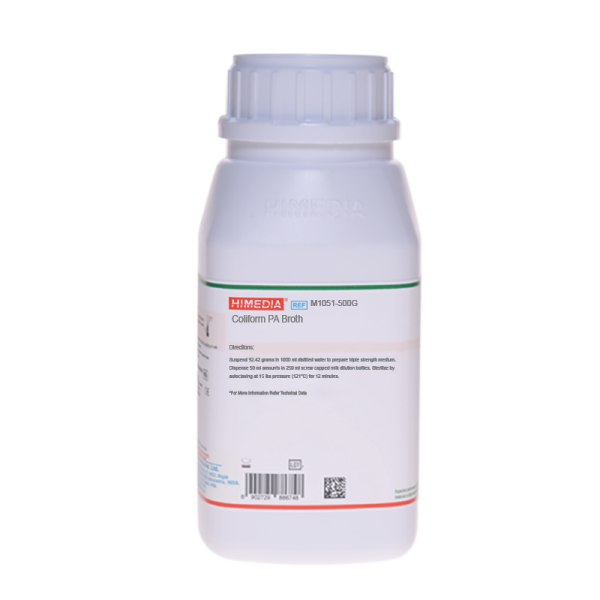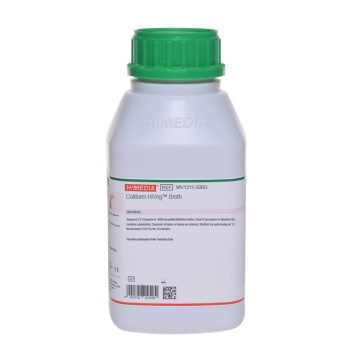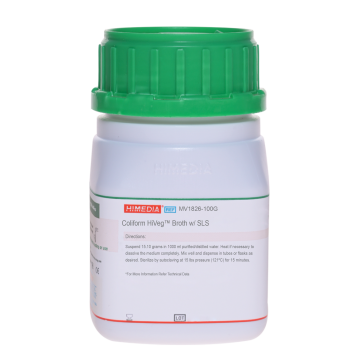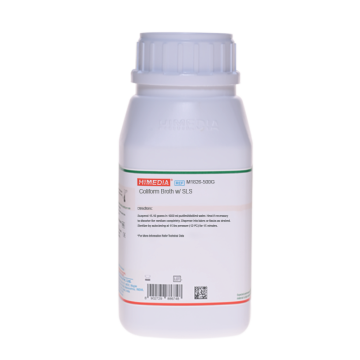 Your enquiry has been submitted
Your enquiry has been submitted
Coliform PA Broth
Intended Use:
Recommended for determination of presence or absence of coliform bacteria in examination of pollution in treated water from water treatment plants or distribution systems.
Composition**
| Ingredients | Gms / Litre |
|---|---|
| Tryptone | 10.000 |
| Gelatin peptone | 5.000 |
| HM peptone B | 3.000 |
| Lactose | 7.500 |
| Dipotassium hydrogen phosphate | 1.375 |
| Potassium dihydrogen phosphate | 1.375 |
| Sodium chloride | 2.500 |
| Sodium lauryl sulphate (SLS) | 0.050 |
| Bromocresol purple | 0.0085 |
| Final pH (at 25°C) | 6.8±0.2 |
**Formula adjusted, standardized to suit performance parameters
Directions
Suspend 92.42 grams in 1000 ml purified / distilled water to prepare triple strength medium. Dispense 50 ml amounts in 250 ml screw capped milk dilution bottles. Sterilize by autoclaving at 15 lbs pressure (121°C) for 12 minutes. Cool to 45-50°C.
Principle And Interpretation
Bacteriological Examination of water samples to determine its suitability for drinking and other domestic purpose has traditionally been done by the most probable number (MPN) procedures or the membrane filter (MF) technique (4). Although these methods have been useful, disadvantages such as space and time requirements prompted the idea of simply testing for the presence or absence of indicator bacteria (3). The presence of enteric pathogens in drinking and recreational waters is of great concern to public health. Therefore, interest in presence absence methods for determining the microbiological quality of drinking water has increased. The presence of total coliforms, faecal coliforms or Escherichia coli is well recognized as an indication of unsafe or poor water quality for which corrective measures should be taken. Coliform Broth is recommended for the isolation and cultivation of coliform organisms from cream, yogurt and raw milk (1).
Coliform PA Broth is used for the determination of presence or absence of coliforms during detection of pollution in treated water from treatment plants or distribution systems. Weiss and Hunter (9) proposed a simple procedure for the bacteriological examination of treated water that should be free of pollution. Later Presence-Absence (P-A) test was developed by Clark as the simplified version of the test, which is based on the principle that coliforms and other bacterial indicators of pollution should not be found in 100ml sample of treated water (3). However the common connotation of “absence” can be misleading in the case of injured bacteria that are frequently present in treated drinking water systems and fail to produce a positive test on established media (8). P-A test has proved to be better than MF (Membrane filter) and FT (Multiple fermentation tube) methods (6). Coliform P-A broth is adaptable for screening of sample for the presence of alternative indicator organisms (4).
Tryptone, Gelatin peptone, and HM peptone B provides nitrogenous and carbonaceous compounds, vitamin B complex and trace ingredients. Lactose is the fermentable carbohydrate. Phosphates provide buffering capacity to the medium while sodium chloride maintains osmotic equilibrium. Bromocresol purple is the pH indicator. Coliforms that ferment lactose produce acid and gas, which is indicated by a change in colour. Sodium lauryl sulphate is inhibitory to many organisms other than coliforms. The P-A analysis of drinking water for total coliforms can entail 100 ml of sample added to 50 ml of triple strength Coliform P-A Broth (M1051) in 250 ml bottles. Bottles containing aliquots of the water sample to be tested are incubated and the results observed. A distinct yellow colour results from the fermentation of lactose and gas production can be detected as bubbles with gentle shaking.
Type of specimen
Water samples
Specimen Collection and Handling
For water samples, follow appropriate techniques for sample collection, processing as per guidelines and local standards (2). After use, contaminated materials must be sterilized by autoclaving before discarding.
Warning and Precautions
Read the label before opening the container. Wear protective gloves/protective clothing/eye protection/face protection. Follow good microbiological lab practices while handling specimens and culture. Standard precautions as per established guidelines should be followed while handling clinical specimens. Safety guidelines may be referred to individual safety data sheets.
Limitations
- Some species may show poor growth due to nutritional variations.
Performance and Evaluation
Performance of the medium is expected when used as per the direction on the label within the expiry period when stored at recommended temperature.
Quality Control
Appearance Cream to yellow homogeneous free flowing powder
Colour and Clarity of prepared medium Purple coloured, clear solution without any precipitate
Reaction Reaction of 9.24% w/v aqueous solution at 25°C. pH: 6.8±0.2
pH 6.60-7.00
Cultural Response Cultural characteristics observed after an incubation at 35-37°C for 18-48 hours.
| Organism | Inoculum (CFU) | Growth | Acid | Gas |
|---|---|---|---|---|
| # Klebsiella aerogenes ATCC 13048 (00175*) | 50-100 | good - luxuriant | positive reaction, yellow colour | positive reaction |
| Escherichia coli ATCC 25922 (00013*) | 50-100 | good - luxuriant | positive reaction, yellow colour | positive reaction |
| Staphylococcus aureus ATCC 25923 (00034*) | >=104 | inhibited | ||
| Salmonella Typhimurium ATCC 14028 (00031*) | 50-100 | good - luxuriant | negative reaction, no colour change | negative reaction |
Key: (*) Corresponding WDCM numbers. (#) Formerly known as Enterobacter aerogenes
Storage and Shelf Life
Store between 10-30°C in a tightly closed container and the prepared medium at 15-25°C. Use before expiry date on the label. On opening, product should be properly stored dry, after tightly capping the bottle in order to prevent lump formation due to the hygroscopic nature of the product. Improper storage of the product may lead to lump formation. Store in dry ventilated area protected from extremes of temperature and sources of ignition Seal the container tightly after use. Use before expiry date on the label.
Product performance is best if used within stated expiry period.
Disposal
User must ensure safe disposal by autoclaving and/or incineration of used or unusable preparations of this product. Follow established laboratory procedures in disposing of infectious materials and material that comes into contact with clinical sample must be decontaminated and disposed of in accordance with current laboratory techniques (5,7).
Reference
- Atlas R. M., 2004, Handbook of Microbiological Media, Lawrence C. Parks (Ed.), 3rd Edition, CRC Press.
- Baird R.B., Eaton A.D., and Rice E.W., (Eds.), 2015, Standard Methods for the Examination of Water and Wastewater, 23rd ed., APHA, Washington, D.C.
- Clark, 1969, Can. J. Microbiol., 5:771.
- Eaton A. D., Clesceri L. S., Rice E. W. and Greenberg A. E., (Eds.), 2005, Standard Methods for the Examination of Water and Wastewater, 21st Ed., APHA, Washington, D.C.
- Isenberg, H.D. Clinical Microbiology Procedures Handbook 2nd Edition.
- Jacobs et al, 1986, Appl. Environ. Microbiol., 51:1007.
- Jorgensen, J.H., Pfaller, M.A., Carroll, K.C., Funke, G., Landry, M.L., Richter, S.S and Warnock., D.W. (2015) Manual of Clinical Microbiology, 11th Edition. Vol. 1.
- McFeters G. A., 1990, Drinking Water Microbiology, Springer-Verlag,New York, pg. 478-492.
- Weiss and Hunter, 1939, J. Am. Water Works Assoc., 31:707.
| Product Name | Coliform PA Broth |
|---|---|
| SKU | M1051 |
| Product Type | Regular |
| Physical Form | Powder |
| Origin | Animal |
| Packaging type | HDPE |
| References | 1. Atlas R. M., 2004, Handbook of Microbiological Media, Lawrence C. Parks (Ed.), 3rd Edition, CRC Press. |
| Customized Product Available | No |











